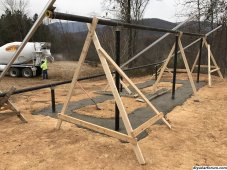The next day the POCO came out and killed the power to the house, and moved the cables from the pole into the new meter base and energized the new panel and left. It then took me about 3 hours to mount the transfer switch and run new 3/0 Cu to the sub-panels in the house. Bending 3/0 Cu is no fun at all, although it was not nearly as bad as the 300 MCM feeding the solar sub-panel.
View attachment 110474
Next I decided to pour a pad and make a "power room" where the service enters the house.
View attachment 110475
Structure done:
View attachment 110476
The roll of cable is a 24 strand fiber cable that I ran down to the shop building since I had ditch dug anyway.
20 kW Kubota generator installed and wired:
View attachment 110477
Last month I decided to ditch all the micro inverters and go 100% SMA SB string inverters. Doing all the ground mounted arrays was easy since I had easy access to the inverters, but the 56 panels on the roof were a different story.
I hauled a pallet up onto the roof, got it level, and the moved the top row of each array section onto it, and then shifted the remaining panels in each row, up one:
View attachment 110479
Inside the shop, I build a frame to hold all the inverters along with the 225A sub-panel. Here's a shot from when the shop roof arrays were still on micro inverters:
View attachment 110481
All done:
View attachment 110483
Closeup of solar sub-panel:
View attachment 110484
Getting that 300 MCM Cu cable to make the turn into the 225A breaker was a real challenge!
All PV wire going into the inverters are 10 AWG and the A/C output of the inverters going to the sub-panel is 6 AWG. The feeder wire from the solar sub-panel to the converted 400A shop meter base is 300 MCM Cu.
Output when the sun is out:
View attachment 110485
Production for the last 30 days:
View attachment 110486








